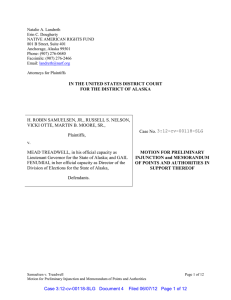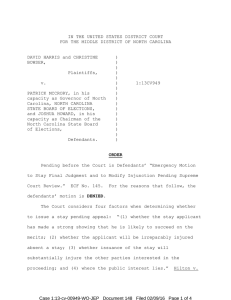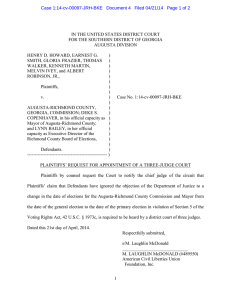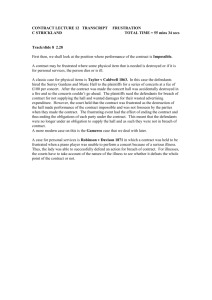Natalie A. Landreth Erin C. Dougherty NATIVE AMERICAN RIGHTS FUND
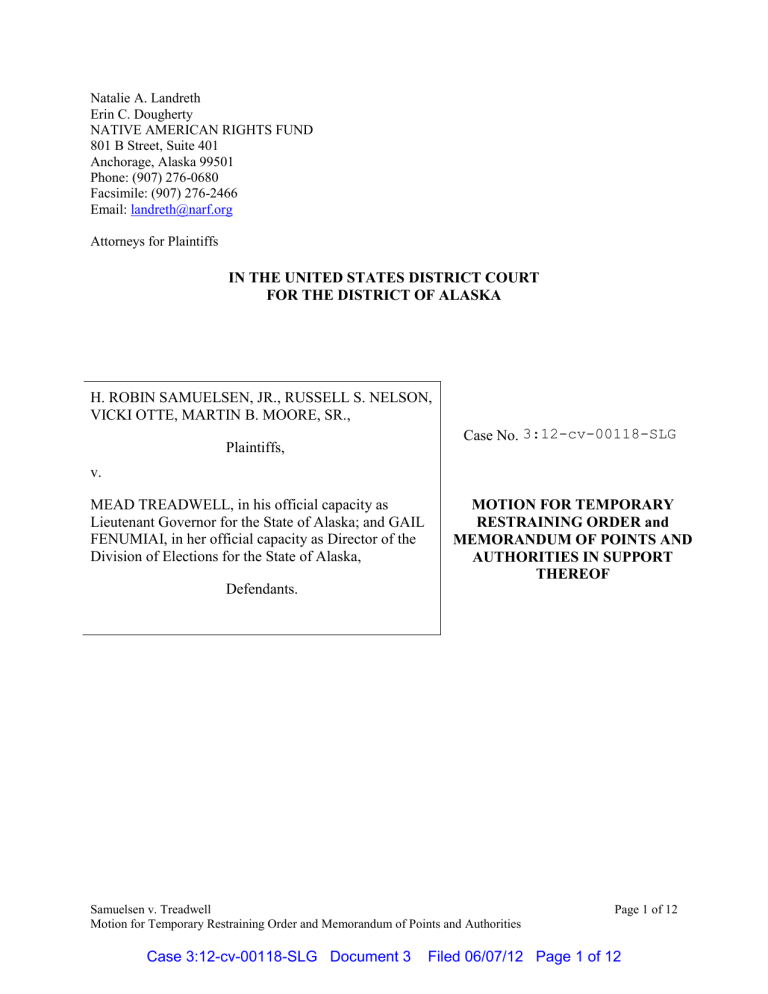
Natalie A. Landreth
Erin C. Dougherty
NATIVE AMERICAN RIGHTS FUND
801 B Street, Suite 401
Anchorage, Alaska 99501
Phone: (907) 276-0680
Facsimile: (907) 276-2466
Email: landreth@narf.org
Attorneys for Plaintiffs
IN THE UNITED STATES DISTRICT COURT
FOR THE DISTRICT OF ALASKA
H. ROBIN SAMUELSEN, JR., RUSSELL S. NELSON,
VICKI OTTE, MARTIN B. MOORE, SR., v.
Plaintiffs,
MEAD TREADWELL, in his official capacity as
Lieutenant Governor for the State of Alaska; and GAIL
FENUMIAI, in her official capacity as Director of the
Division of Elections for the State of Alaska,
Defendants.
Case No. 3:12-cv-00118-SLG
MOTION FOR TEMPORARY
RESTRAINING ORDER and
MEMORANDUM OF POINTS AND
AUTHORITIES IN SUPPORT
THEREOF
Samuelsen v. Treadwell
Motion for Temporary Restraining Order and Memorandum of Points and Authorities
Page 1 of 12
Case 3:12-cv-00118-SLG Document 3 Filed 06/07/12 Page 1 of 12
MOTION FOR TEMPORARY RESTRAINING ORDER
Pursuant to Federal Rule of Civil Procedure 65(b), Plaintiffs move for a temporary restraining order restraining Defendants and their employees, agents, and successors in office, from employing an unprecleared redistricting map (the Amended Proclamation Plan) to prepare for and conduct the statewide Primary Election scheduled for August 28, 2012 and any future elections (including candidate qualifying) unless and until such plan is precleared by the U.S.
Department of Justice (“DOJ”) or the U.S. District Court for the District of Columbia. See 42
U.S.C. § 1973c. In actions to enjoin violations of Section 5 of the Voting Rights Act (“VRA”), a single-judge federal court has the authority to issue a temporary restraining order to remain in place until a three-judge court can be convened to consider an application for a preliminary injunction. See 28 U.S.C. § 2284(b)(3); Puerto Rican Legal Def. Fund (“PRLDEF”) v. City of
New York , 769 F. Supp. 74, 75-76 (E.D.N.Y. 1991). Therefore, the Court, sitting as a singlejudge, has the authority to issue the temporary restraining order that Plaintiffs have requested.
More particularly, Plaintiffs request that a temporary restraining order be issued under
Rule 65(b) and 28 U.S.C. § 2284(b)(3) solely to preserve the status quo of the current districts
(also called “the benchmark”) until such time as the three-judge court may convene for a preliminary injunction hearing. The request for a temporary restraining order is supported by the following memorandum of points and authorities, affidavit and exhibits. Plaintiffs intend to give notice of this motion and all accompanying documents by personal service immediately, thus the order would not have to be issued without notice to Defendants.
Plaintiffs’ primary concern is that the damage caused by Defendants’ actions in preparing to conduct an election under an illegal redistricting plan, including their decision to conduct and close candidate qualifying under that illegal plan, will only compound further if not restrained
Samuelsen v. Treadwell
Motion for Temporary Restraining Order and Memorandum of Points and Authorities
Page 2 of 12
Case 3:12-cv-00118-SLG Document 3 Filed 06/07/12 Page 2 of 12
immediately. Significant harm will occur before the Chief Circuit Judge can convene the threejudge panel required, schedule a hearing and make a decision. One deadline (the candidate filing deadline) has already passed and the Defendants have scheduled other actions for “mid June” of
2012 using the illegal redistricting plan. Landreth Affidavit, Ex. A. In the meantime, candidates who have “qualified” under the illegal plan will continue to spend time and money campaigning in districts (some of which are more than a thousand miles across and extremely expensive to traverse), including those in which the Plaintiffs reside. All further steps taken by the
Defendants to implement the illegal plan must be stopped immediately to avoid further harm to the Plaintiffs.
Counsel for Plaintiffs is not scheduled to travel in the near future and can be available for a hearing on a temporary restraining order any time between Monday, June 11 th
of June and
Friday July 13 th
with the following exceptions: June 18 from 9am-noon and July 2 from 9amnoon. Otherwise, Plaintiffs’ counsel can adjust their schedules to be available at the Court’s and opposing counsel’s convenience.
MEMORANDUM OF POINTS AND AUTHORITIES
Federal courts have routinely held that the traditional standard for preliminary injunctions does not apply to Section 5 claims. Thus, issuance of a temporary restraining order should also not be governed by these standards. Instead, federal courts have established a separate test for these unique claims.
Section 5 of the VRA is a unique federal remedy, barring implementation of voting changes “without any need for prior adjudication.”
South Carolina v. Katzenbach , 383 U.S. 301,
327-28 (1966). Section 5 provides that any “voting qualification or prerequisite to voting, or standard, practice, or procedure with respect to voting” different from that in force or effect in
Samuelsen v. Treadwell
Motion for Temporary Restraining Order and Memorandum of Points and Authorities
Page 3 of 12
Case 3:12-cv-00118-SLG Document 3 Filed 06/07/12 Page 3 of 12
the State of Alaska or its subdivisions on November 1, 1972, may not be lawfully implemented unless such change has been submitted to the U.S. Attorney General, and the U.S. Attorney
General has not interposed an objection within sixty days, or the jurisdiction obtains a declaratory judgment from the U.S. District Court for the District of Columbia that the change
“neither has the purpose nor will have the effect of denying or abridging the right to vote on account of race or color” or membership in a language minority group. 42 U.S.C. § 1973c(a).
“If a voting change subject to § 5 has not been precleared, § 5 plaintiffs are entitled to an injunction prohibiting implementation of the change.”
Lopez v. Monterey County , 519 U.S. 9, 20
(1996) (emphasis added). The standards for a violation of Section 5 are well established: “The three-judge district court may determine only whether § 5 covers a contested change, whether §
5’s approval requirements were satisfied, and if the requirements were not satisfied, what temporary remedy, if any, is appropriate.” Id.
at 23-24.
Federal courts have substituted the three elements of a Section 5 claim for the four factors traditionally considered in assessing a request for injunctive relief. As one three-judge court explained:
We have reviewed numerous cases in which a three-judge panel was convened pursuant to 42 U.S.C. § 1973c and 28 U.S.C. § 2284, and we have found no persuasive authority for the proposition that the traditional preliminary injunction test applies to claims for injunctive relief in the face of a § 5 preclearance violation. Rather, three-judge courts like this one have engaged in the three-part inquiry we have outlined above, namely, whether a voting change is covered by
§ 5, whether that change has been precleared by the Attorney General or the
District Court for the District of Columbia, and if not, what remedy is appropriate.
Three-judge courts convened as we are have gone no further.
United States v. Louisiana , 952 F. Supp. 1151, 1159-61 (W.D. La.) (three-judge court)
(collecting numerous citations), aff’d , 521 U.S. 1101 (1997). Therefore, a “fair reading of the cases in which § 5 of the Voting Rights Act was the basis for injunctive relief justifies the
Samuelsen v. Treadwell
Motion for Temporary Restraining Order and Memorandum of Points and Authorities
Page 4 of 12
Case 3:12-cv-00118-SLG Document 3 Filed 06/07/12 Page 4 of 12
conclusion that the traditional requirements for relief are not applicable.”
See PRLDEF , 769 F.
Supp. at 78. Rule 65 supports that conclusion because it does not modify any federal statute, such as Section 5 of the VRA, which provides specific requirements for injunctive relief. See id. at 79 (citing Fed. R. Civ. P. 65(e)). Consequently, Plaintiffs respectfully submit that the threejudge Court should apply the three factors for establishing preclearance violations in adjudicating
Plaintiffs’ request for injunctive relief on their Section 5 claims.
With respect to the first factor, the use of an entirely new redistricting plan clearly constitutes a covered voting change requiring preclearance. 42 U.S.C. § 1973c(a); 28 C.F.R. §
55.22. Indeed, there can be no bigger voting change. Specifically, Defendants have begun implementing this plan by (1) instructing candidates to file under the districts in the Amended
Proclamation Plan; (2) closing candidate filing on Friday, June 1, using the districts in the
Amended Proclamation Plan; (3) certifying candidates using the districts in the Amended
Proclamation Plan; (4) adopting and posting on their website emergency regulations outlining the precinct boundary descriptions using the Amended Proclamation Plan; and (5) creating and posting on their website maps of the districts using the Amended Proclamation Plan. Affidavit of Natalie Landreth ¶ 2-6, Exhibits A-C. In addition, the Division of Elections website indicates that it has “inactivated the On-line Polling Place Lookup, List of Polling Place Locations,
Telephone Polling Place Locator and the Voter Registration Status Online Tool until the final phases of the redistricting process have been completed.” Landreth Affidavit ¶ 1, Exhibit A.
The website also indicates “[w]e anticipate these features being activated mid-June.” Landreth
Affidavit ¶ 1, Exhibit A. Not only have the defendants begun implementing these changes, but also they clearly plan to continue to do so.
Samuelsen v. Treadwell
Motion for Temporary Restraining Order and Memorandum of Points and Authorities
Page 5 of 12
Case 3:12-cv-00118-SLG Document 3 Filed 06/07/12 Page 5 of 12
There can be no doubt that these changes are of the type that requires preclearance. This is especially so given that courts have interpreted the term “change” broadly. Previously, covered jurisdictions that failed to submit changes would argue that the changes were small and therefore did not require preclearance. Courts uniformly rejected this:
Our precedents recognize that to effectuate the Congressional purpose, § 5 is to be given broad scope. Also, far from excepting alterations that might be perceived as minor, Congress failed to adopt such a suggestion when it was proposed in debates on the original Act. . . . And, as it had in previous extensions of the Act,
Congress specifically endorsed a broad construction of the provision.
NAACP v. Hampton County Election Comm’n, 470 U.S. 166, 176 (1985) (citations omitted)
(holding that rescheduling a candidate qualifying period is a change that comes within the scope of section 5 and thus requires preclearance); see also Allen v. State Bd. of Elections , 393 U.S.
544, 565-71 (1969) (holding that Section 5 applies broadly to even small or subtle changes affecting the right to vote). Similarly, it does not matter if the change is triggered by a new statute, referendum or even a state court opinion; the only way a change can be lawfully enforced is if it has been precleared. See, e.g. Hampton County, 470 U.S. at 175 n. 19 (“Generally statutes that are subject to § 5 are ineffective as laws until they have been cleared by federal authorities,” citing Connor v. Waller, 421 U.S. 656 (1975) (per curiam)).
Federal courts have repeatedly held that a covered jurisdiction, such as Alaska, cannot initiate and conduct candidate qualifying – much less close candidate qualifying, as Defendants already have done – using an unprecleared redistricting plan. See , e.g.
, Hampton County , 470
U.S. at 176-77; PRLDEF , 769 F. Supp. at 76-78; South Carolina v. United States , 585 F. Supp.
418, 422 (D.D.C. 1984) (three-judge court); Busbee v. Smith , 549 F. Supp. 494, 497 n.1 (D.D.C.
1982) (three-judge court), aff’d on other grounds , 459 U.S. 1166 (1983). For example, in South
Carolina v. United States
, the court considered “whether candidate qualification filing and
Samuelsen v. Treadwell
Motion for Temporary Restraining Order and Memorandum of Points and Authorities
Page 6 of 12
Case 3:12-cv-00118-SLG Document 3 Filed 06/07/12 Page 6 of 12
certain other steps being taken … in preparation for the primary elections constitute
‘implementation’ of an unprecleared voting change.” 585 F. Supp. at 421. The court held that it was, reasoning:
South Carolina … asserts that “mere candidate filing for party primaries does not constitute implementation of Act 257 [the unprecleared redistricting plan].
Rather, it says, such activity implements, if anything, the general state law … which was precleared by the Attorney General … and which provides [for candidate qualifying].
South Carolina’s thesis that its candidate filing procedures implement only the precleared [statute] is specious. Aspiring … candidates .. are filing to stand for election in districts laid out by Act 257, not by [the precleared statute] … in order to prepare for what South Carolina hopes will be an early summer primary, occurring pursuant to a precleared Act 257… It is obvious that South Carolina is implementing the unprecleared Act 257 through candidate filing procedures, as well as any other activities it plans in anticipation of the … primary.
This Court is satisfied, as was the Busbee court, that candidate qualification under an as yet unprecleared districting plan is “implementation” of a voting change within the meaning of Section 5 of the Voting Rights Act.
Id.
at 422 (citing Busbee v. Smith , 549 F. Supp. at 497 n.1). The same reasoning applies here because the Defendants have already implemented and closed candidate qualifying under the unprecleared Amended Proclamation Plan, in direct violation of Section 5.
The harm caused by the Defendants’ unlawful implementation of the illegal plan is immediate and clear. Earlier this year the Florida Secretary of State acknowledged the wellaccepted rule that covered jurisdictions cannot initiate candidate qualifying procedures under an unprecleared redistricting plan. The Secretary reasoned, “candidate qualifying is districtspecific; a candidate cannot change districts after qualifying. A legally-enforceable apportionment plan … must be in place before the qualifying period to that prospective candidates will be able to determine whether they will run for office and in which district they will be located.”
In re Senate Joint Resolution of Legis. Apportionment 2-B , 2012 Fla. LEXIS
Samuelsen v. Treadwell
Motion for Temporary Restraining Order and Memorandum of Points and Authorities
Page 7 of 12
Case 3:12-cv-00118-SLG Document 3 Filed 06/07/12 Page 7 of 12
834, at **54-55 n.14 (Fla. Apr. 27, 2012) (emphasis added). For that reason, an enforceable redistricting plan must be in place before candidate qualifying begins . See generally Smith v.
Clark , 189 F. Supp. 2d 503, 504-05 (S.D. Miss. 2002) (three-judge panel) (implementing an interim redistricting plan because of upcoming candidate qualifying deadlines). A covered jurisdiction cannot avoid the requirement that the redistricting plan first be precleared under
Section 5 merely by representing that it will not hold elections under the plan if it is not precleared. See South Carolina v. United States , 585 F. Supp. at 421. The only way to avoid the harm caused by implementation of the illegal redistricting plan through candidate qualifying and other activities antecedent to an election is to enjoin all such activities unless and until the
Amended Proclamation Plan is precleared. See generally PRLDEF , 769 F. Supp. at 76-78
(summarizing the cases discussed above).
With respect to the second factor, it cannot be disputed that this change has not received preclearance from DOJ. The redistricting plan upon which Defendants are relying was only just submitted on May 25, 2012. DOJ may take up to 60 days to review the submission under
Section 5 before it must either determine whether to preclear the plan, reject the submission as incomplete, or to restart the review period to 60 days from the date it receives more information requested from the jurisdiction. See 42 U.S.C. § 1973c(a); 28 C.F.R. §§ 51.35, .37-.38.
Moreover, the Defendants have indicated quite clearly on their website that the Amended
Proclamation Plan is being employed to certify candidates and establish new district boundaries
“pending preclearance.” Landreth Affidavit ¶ 1-6, Exhibits A-C. There is absolutely no evidence that Defendants have received preclearance for any of the changes being implemented under the Amended Redistricting Plan.
Samuelsen v. Treadwell
Motion for Temporary Restraining Order and Memorandum of Points and Authorities
Page 8 of 12
Case 3:12-cv-00118-SLG Document 3 Filed 06/07/12 Page 8 of 12
With respect to the third and final factor, the remedy is clear: the Defendants should be temporarily restrained from employing the unprecleared Amended Proclamation Plan to prepare for and conduct an election, including through candidate qualifying and other activities antecedent to the election, unless and until such a plan is precleared. Furthermore, the Court should “invalidate any past implementation, including that effected by candidates’ filing qualifications” with the DOE under the unprecleared Amended Proclamation Plan.
South
Carolina v. United States , 585 F. Supp. at 424. Moreover Defendants and their “officers, agents, servants, employees, and attorneys and all others in active concert or participation” with them should be “ordered and directed to accord them no legal force and effect until, unless, and except as the Court may otherwise determine.”
Id.
at 425. Without a restraining order in place, campaigning will begin under an illegal redistricting plan with unlawfully qualified candidates on the ballot – a totally unacceptable result and one that is repugnant to democratic principles.
The damage caused by Defendants’ actions cannot be overstated. The right to vote is one of the most fundamental rights in our system of government. Reynolds v. Sims , 377 U.S. 533,
554 (1964); Harman v. Forssenius , 380 U.S. 528, 537 (1965); Elrod v. Burns , 427 U.S. 347, 373
(1976); Idaho Coalition United for Bears v. Cenarussa , 342 F.3d 1073, 1076 (9th Cir. 2003).
The right to vote is entitled to special constitutional protection because:
The right to vote freely for the candidate of one's choice is of the essence of a democratic society, and any restrictions on that right strike at the heart of representative government. . . . [T]he right to exercise the franchise in a free and unimpaired manner is preservative of other basic civil rights.
Reynolds v. Sims , 377 U.S. at 555, 562; accord Wesberry v. Sanders , 376 U.S. 1, 17 (1964)
(“[o]ther rights, even the most basic, are illusory if the right to vote is undermined”). Because of the preferred place it occupies in our constitutional scheme, “any illegal impediment to the right
Samuelsen v. Treadwell
Motion for Temporary Restraining Order and Memorandum of Points and Authorities
Page 9 of 12
Case 3:12-cv-00118-SLG Document 3 Filed 06/07/12 Page 9 of 12
to vote, as guaranteed by the U.S. Constitution or statute, would by its nature be an irreparable injury.” Harris v. Graddick , 593 F. Supp. 128, 135 (M.D. Ala. 1984), opinion withdrawn on other grounds , 615 F. Supp. 239 (M.D. Ala. 1985); accord Dillard v. Crenshaw County , 640 F.
Supp. 1347, 1363 (M.D. Ala. 1986) (“denial of the right to vote” constitutes irreparable injury);
Foster v. Kusper , 587 F. Supp. 1191, 1193 (N.D. Ill. 1984); see also Elrod v. Burns , 427 U.S.
347, 373 (1976) (the loss of constitutionally protected freedoms “for even minimal periods of time, constitutes irreparable injury”). “Federal courts have recognized that the holding of an upcoming election in a manner that will violate the Voting Rights Act constitutes irreparable harm to voters.”
United States v. Berks County , 250 F. Supp.2d 525, 540 (E.D. Pa. 2003)
(collecting citations).
Given the importance of the right, the remedy requested is reasonable and proper – indeed mandated by law – and administrative convenience of Defendants simply pales in comparison. “Although these reforms may result in some administrative expenses for
Defendants, such expenses are likely to be minimal and are far outweighed by the fundamental right at issue.”
Berks County , 250 F. Supp.2d at 541; see also Johnson v. Halifax County, N.C.
,
594 F. Supp. 161, 171 (E.D.N.C. 1984) (finding that administrative and financial burdens on defendant jurisdiction were not undue in light of irreparable harm caused by the county).
“Administrative convenience” cannot justify a state practice that impinges upon a fundamental right such as the right to vote. Taylor v. Louisiana , 419 U.S. 522, 535 (1975). Furthermore, it was the dilatoriness of the Alaska Redistricting Board and Defendants, who waited approximately 50 days after formally adopting the Amended Proclamation Plan to submit it for preclearance, which caused this problem in the first place. The Plaintiffs, and indeed all citizens of Alaska, should not be subjected to illegal preparations for an election simply because the
Samuelsen v. Treadwell
Motion for Temporary Restraining Order and Memorandum of Points and Authorities
Page 10 of 12
Case 3:12-cv-00118-SLG Document 3 Filed 06/07/12 Page 10 of 12
entities responsible for developing the plan and administering elections did not act in a timely fashion. To allow such excuses would create a perverse incentive for jurisdictions to wait until the very last minute to submit their plans and then throw up their hands claiming “we don’t have any time, we must proceed under this plan.” In any event, the Defendants’ unlawful actions in implementing the unprecleared Amended Proclamation Plan, through candidate qualifying and other actions preparing for elections under the illegal Plan, clearly violate Section 5 of the VRA and must be restrained pending a preliminary injunction hearing. See, e.g., PRLDEF , 769 F.
Supp. at 79; South Carolina v. United States , 585 F. Supp. at 424-25; Busbee , 549 F. Supp. at
497 n.1.
For all of the foregoing reasons, Plaintiffs respectfully request that the single-judge Court
GRANT the Motion for a Temporary Restraining Order until such time as the three-judge court can be convened to hear the Motion for Preliminary Injunction filed herewith. Consistent with the holdings of the cases addressed above, which involved similar circumstances in which a covered jurisdiction began candidate qualifying and other antecedent activities under an unprecleared redistricting plan, Plaintiffs further request that the temporary restraining order do the following: (1) declare the candidate qualification filings under the unprecleared Amended
Proclamation Plan null, void, and of no effect; (2) order the Defendants and their officers, agents, servants, employees, and attorneys, and all others in active concert or participation with them to accord the candidate qualifying filings and certifications of no legal force and effect until, unless, and except as the Court may subsequently otherwise determine; and (3) order the Defendants and their officers, agents, servants, employees, and attorneys, and all others in active concert or participation with them to neither require nor permit any other or further action on their part taken in connection with an activities or other actions antecedent to elections under the
Samuelsen v. Treadwell
Motion for Temporary Restraining Order and Memorandum of Points and Authorities
Page 11 of 12
Case 3:12-cv-00118-SLG Document 3 Filed 06/07/12 Page 11 of 12
unprelceared Amended Proclamation Act until that Act “has been finally precleared pursuant to
Section 5” of the VRA. South Carolina v. United States , 585 F. Supp. at 424-25.
DATED this 6 th
day of June 2012.
Respectfully submitted, s/nlandreth
Natalie A. Landreth (Bar no. 0405020)
Erin C. Dougherty (Bar no. 0811067)
NATIVE AMERICAN RIGHTS FUND
801 B Street, Suite 401
Anchorage, Alaska 99501
Phone: (907) 276-0680
Facsimile: (907) 276-2466
Email: landreth@narf.org
dougherty@narf.org
Samuelsen v. Treadwell
Motion for Temporary Restraining Order and Memorandum of Points and Authorities
Page 12 of 12
Case 3:12-cv-00118-SLG Document 3 Filed 06/07/12 Page 12 of 12
